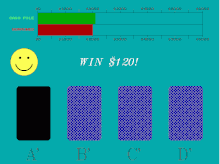Iowa Gambling Task
The Iowa Gambling Task ( IGT , rarely also "Bechara's Gambling Task"; English : Iowa gambling task , named after the research location of the developer, the University of Iowa ) is an experimental paradigm for realistic decision-making situations with regard to high uncertainty about positive and negative results map. In the short term, great successes can be achieved with a long-term disadvantage, compared to short-term mediocre successes with long-term profit - provided the test person can derive a system or if the decision is influenced by somatic markers . The IGT was founded byAntoine Bechara , António & Hanna Damásio and Steven Anderson and has been widely cited since then .
Experimental setup
Test subjects (VP) can take a playing card from one of the four card stacks in several rounds , with each pile being assigned a certain amount of winnings and the test subject being allocated starting capital of 2000 US dollars ($) play money . With a card in the two stacks on the left ("A" & "B") the participant receives $ 100, with a card in the two stacks on the right ("C" & "D") $ 50. After a few rounds, the VP receives a fine of an unknown amount, although the number of rounds the VP has made is also unknown. The penalty for stacks A & B is significantly higher than that of stacks C & D. After ten rounds, the VP only loses stacks A & B for cards (net loss of $ 250 on previous ten times $ 100 profit) - with ten rounds of cards from deck C & D there is a profit (net profit of $ 250 with ten times $ 50 minus a penalty of only $ 250). The aim is to acquire as much play money as possible.
Prediction & Results
The IGT is intended to simulate decision-making in everyday life and to check whether the somatic marker hypothesis is valid. Accordingly, test subjects with a lesion in the ventromedial prefrontal cortex (vmPFC) should do worse than their control group .
Already in the first study with IGT in 1994 it was found that patients with damaged ventromedial prefrontal cortex (vmPFC) were unable to learn that there were long-term advantageous versus disadvantageous stacks of cards - even if the reactions (the change in the Skin resistance ) of the VPs with damage in the VMPFC showed the same reactions to gain and loss as a control group; but at different times. While the control group anticipated the result and the skin resistance showed a change before a decision was made in favor of a deck of cards, this deviation did not appear in test subjects with damage in the vmPFC until after this.
Bechara et al. viewed the changed skin resistance as a "somatic marker", this was - following the experiment - decisive for the orientation of the test subjects towards the long-term advantageous deck of cards.
Individual evidence
- ↑ Jerome R. Busemeyer, Julie C. Stout: A contribution of cognitive decision models to clinical assessment: Decomposing performance on the Bechara gambling task .. In: Psychological Assessment. 14, 2002, pp. 253-262, doi : 10.1037 / 1040-3590.14.3.253 .
- ↑ Barnaby D. Dunn, Tim Dalgleish, Andrew D. Lawrence: The somatic marker hypothesis: A critical evaluation. In: Neuroscience & Biobehavioral Reviews. 30, 2006, pp. 239-271, doi : 10.1016 / j.neubiorev.2005.07.001 .
- ↑ Ulf Hlobil: A theoretical critique of Antonio Damasio's somatic marker hypothesis , diploma thesis, September 14, 2008.
- ↑ Peter Kenning : Consumer Neuroscience - a transdisciplinary textbook , Kohlhammer Verlag , Stuttgart 2014, ISBN 978-3-17-020727-1 .
